跨文化交际——理论与实践Unit 1
- 格式:ppt
- 大小:4.16 MB
- 文档页数:19
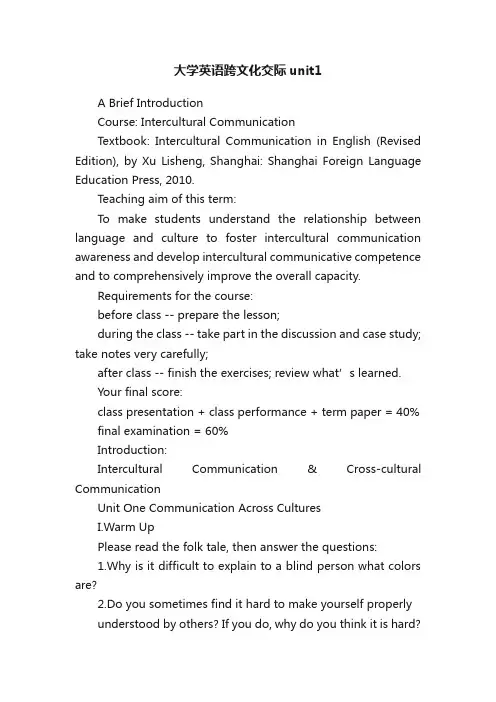
大学英语跨文化交际unit1A Brief IntroductionCourse: Intercultural CommunicationTextbook: Intercultural Communication in English (Revised Edition), by Xu Lisheng, Shanghai: Shanghai Foreign Language Education Press, 2010.Teaching aim of this term:To make students understand the relationship between language and culture to foster intercultural communication awareness and develop intercultural communicative competence and to comprehensively improve the overall capacity.Requirements for the course:before class -- prepare the lesson;during the class -- take part in the discussion and case study; take notes very carefully;after class -- finish the exercises; review what’s learned.Your final score:class presentation + class performance + term paper = 40% final examination = 60%Introduction:Intercultural Communication & Cross-cultural CommunicationUnit One Communication Across CulturesI.Warm UpPlease read the folk tale, then answer the questions:1.Why is it difficult to explain to a blind person what colors are?2.Do you sometimes find it hard to make yourself properlyunderstood by others? If you do, why do you think it is hard?II.Reading1.Read the article of “Intercultural Communication: An Introduction”and answer the questions.Supplement:What is intercultural communication (IC)? What do you know about it?1.DefinitionIC is concerned with communication among people from different cultural backgrounds.Intercultural communication refers to communication between people whose cultural perception and symbol system are distinct enough to alter the communication event.2.Forms of IC(1) International Communication: International communication takes place between nations and governments rather than individuals; it isquite formal and ritualized(仪式化) .(2) Interethnic Communication: Ethnic groups usually form their own communities in a country or culture. These groups share a common origin or heritage that is apt to influence family names, language, religion, values, and the like.(3) Interracial Communication: Interracial communication occurs when the sender and thereceiver exchanging messages are from different races.(4) Intracultural Communication: It is defined as communication between or among members of the same culture.3.Features(1)It is a branch of communication.(2)It mainly deals with verbal and nonverbal interaction andrelatedfactors in intercultural communication.(3)Its verbal medium is language while its nonverbal communicationsystems include body language, facial expressions, etc.2.Read the article of “The Challenge of Globalization” on page 13-16and answer the questions?Supplement: History and Present State of IC Studies(1)IC and IC studiesIC studies are rather new while IC (activities) is almost as long as our human history:(2)IC Studies in USA and ChinaIn 1950s and 1960s America, as the most powerful country, had frequent contacts with other countries. Some of these activities were successful but others were failures. Some of the Americans left a bad or even disgusting impression on the native people. Thus in 1958 The Ugly American shows the American officials in Southeast Asia. (The trigger of IC studies)In 1959 The Silent Language by American cultural anthropologist Edward Hall signified the emergence of this discipline.This course was offered in USA in late 1960s in five universities. Since 1970s it has been popular in USA with 200 universities and 60 graduated schools offering it in 1978.This course was introduced to the Chinese scholars in 1980s. According to Hu Wenzhong in 1995 there were only Beijing Foreign Studies University, Heilongjiang University, Harbin Industrial University, Shanghai Foreign Studies University and Fujian Teachers University. It is rather new in China.Homework: Read the article of “Stumbling Blocks in Intercultural Communication”. Some questions will be asked next class.3. Read the story on page 9, then discuss the question: Which do you think is the mark of beauty, thin or fat? Why is it often said that beauty is in the eye of the beholder?4. Discuss the cases of communication given on page 11-12 is possibly intercultural or not and, if it is, to what extent it is intercultural.5. Read these two different views on IC mentioned on page 12, then state your point of view clearly and support your argument with convincing and substantial evidence.6. Read the story of “How We Address Each Other?” and identify the differences on addressing between Chinese people and Americans.Supplement(补充): formal situation In England , people call each other by firstname, such as between employers andemployees.in less formal settings People usually use first name, even they meetfor the first time, regardless of age and statusinformal situation first names are less likely to be usedin many officesuse of the first name among colleagues iscustomary; use the title plus last name wouldbe taken as an open declaration of dislikesomeone.Mr. / Mrs. / Miss. / Ms.the most frequentused titlesSir / Madam / Mack / Buddy / mategeneral terms ofaddressguyscollective informaltermsterms of endearment husband & wife / dear / darling / love Notes on English Titles1. In informal situations, people usually call each other by their first names.2. Mutual use of first names does not in every situation imply friendship and intimacy.3. Use of title plus last name in an informal circumstance is still avoided. It would be taken as being too cold, an open declaration of dislike.4. Children often address schoolmistresses(女教师)simply as 'Miss' without adding their surnames.5. "Sir" and "Madam" without adding their surnames are usually addressed by people like shop-assistants or air-hostesses.6. When "Sir" is used before a life peer in Britain, it is of course a title of lords. The word can be used before a person's whole name like"Sir Beatle Paul McCartney" or just with the first name alone like "Sir Paul".7. In English professional titles, the most commonly used three are Doctor(博士),Professor and Doctor(医生) that can go together with a person's name. Other titles that can be used together with a person's name are Queen (Queen Mary 玛丽女王),Prince (Prince Charles),President (PresidentClinton),Senator (Senator Fulbright议员), Judge (Judge Harley 法官), Father (Father White神父),General (General Patten), Colone (Colonel Quail上校)and so on.III.Case Study: Students are required to read the cases given carefully and try to analyse them from the viewpoint of IC.。

《跨文化交际的理论与实践》跨文化交际的理论与实践随着全球化的加速,不同国家和地区之间的交流、合作和交往活动日益频繁,跨文化交际也因此成为一门十分重要的学科。
跨文化交际研究的对象是不同文化背景下的人们之间的互动和交往,包括口头和非口头语言传达、行为习惯、价值观念、社会习俗等多个方面。
跨文化交际的理论与实践涉及到语言学、社会学、认知心理学等多个学科,其研究成果可以有效指导人们在跨文化交际中规避误解和冲突,促进文化交流和合作,为全球化的进程提供重要的智力支持。
跨文化交际理论的发展历程跨文化交际理论的发展可以追溯到20世纪50年代,当时人们开始重视跨文化交往中的语言和文化差异,认为跨文化交往中的失误和冲突主要是由于语言和文化的差异所导致的。
在此基础上,语言学家弗朗西斯·霍奇森(Hall)、爱德华·塔勒(Taylor)等学者先后提出了“高低语境文化”、“文化差异”等概念,来描述跨文化交际中的语言和文化差异。
这些概念为跨文化交际的理论构建奠定了基础。
20世纪60年代以后,跨文化交际理论逐步发展成为集语言、文化、心理等多方面知识于一体的学科。
美国语言学家萨姆·华兹(Hudson)发表了《跨文化交际研究理论框架的建立》一文,强调跨文化交际不仅仅是语言和文化的问题,还涉及许多其他因素,如情感、人际关系等。
英国古典语言学家约翰·加尔弗兰(Garfinkel)则提出了“文化话语分析”(CA),认为人们的行为在很大程度上是由文化环境所约束的。
这些理论对跨文化交际的研究和实践产生了重要影响。
跨文化交际理论的重要概念1、高低语境文化高低语境文化是跨文化交际中的一个重要概念,它是美国语言学家霍奇森提出的。
高低语境文化主要来自于对文化中信息表达方式的不同理解。
在低语境文化中,信息表达以直白、准确、直接为主,它以清楚明确的文字语言为主要传播方式;而在高语境文化中,信息表达方式则依赖于身份、关系、文化等诸多因素的复杂交织,语言的隐喻、暗示、表情等非语言因素也更多地发挥作用。

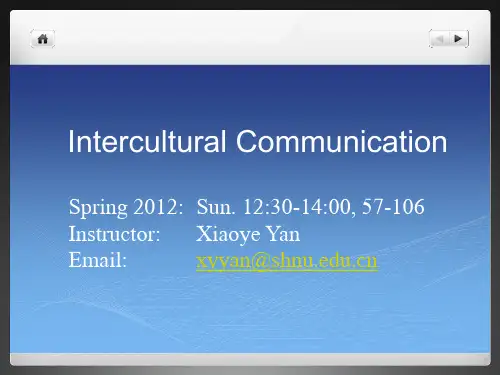
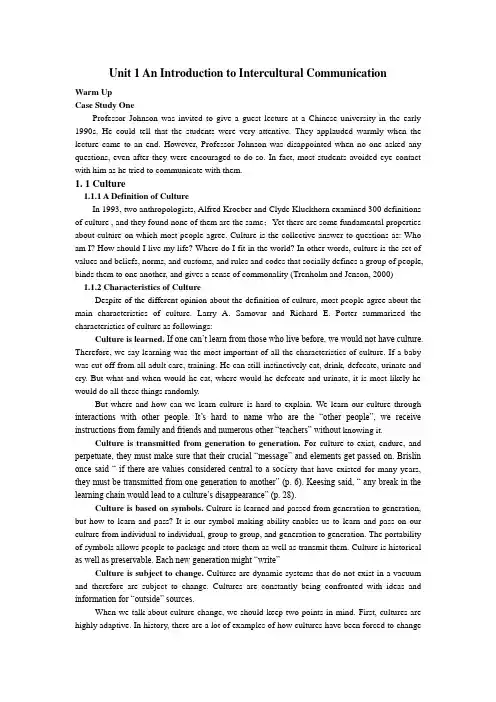
Unit 1 An Introduction to Intercultural CommunicationWarm UpCase Study OneProfessor Johnson was invited to give a guest lecture at a Chinese university in the early 1990s. He could tell that the students were very attentive. They applauded warmly when the lecture came to an end. However, Professor Johnson was disappointed when no one asked any questions, even after they were encouraged to do so. In fact, most students avoided eye contact with him as he tried to communicate with them.1. 1 Culture1.1.1 A Definition of CultureIn 1993, two anthropologists, Alfred Kroeber and Clyde Kluckhorn examined 300 definitions of culture , and they found none of them are the same;Yet there are some fundamental properties about culture on which most people agree. Culture is the collective answer to questions as: Who am I? How should I live my life? Where do I fit in the world? In other words, culture is the set of values and beliefs, norms, and customs, and rules and codes that socially defines a group of people, binds them to one another, and gives a sense of commonality (Trenholm and Jenson, 2000)1.1.2 Characteristics of CultureDespite of the different opinion about the definition of culture, most people agree about the main characteristics of culture. Larry A. Samovar and Richard E. Porter summarized the characteristics of culture as followings:Culture is learned.If one can’t learn from those who live before, we would not have culture. Therefore, we say learning was the most important of all the characteristics of culture. If a baby was cut off from all adult care, training. He can still instinctively eat, drink, defecate, urinate and cry. But what and when would he eat, where would he defecate and urinate, it is most likely he would do all these things randomly.But where and how can we learn culture is hard to explain. We learn our culture through interactions with other people. It’s hard to name who are the “other people”, we receive instructions from family and friends and numerous other “teachers” without knowing it.Culture is transmitted from generation to generation.For culture to exist, endure, and perpetuate, they must make sure that their crucial “message” and elements get passed on. Brislin once said “ if there are values considered central to a soc iety that have existed for many years, they must be transmitted from one generation to another” (p. 6). Keesing said, “ any break in the learning chain would lead to a culture’s disappearance” (p. 28).Culture is based on symbols. Culture is learned and passed from generation to generation, but how to learn and pass? It is our symbol-making ability enables us to learn and pass on our culture from individual to individual, group to group, and generation to generation. The portability of symbols allows people to package and store them as well as transmit them. Culture is historical as well as preservable. Each new generation might “write”Culture is subject to change. Cultures are dynamic systems that do not exist in a vacuum and therefore are subject to change. Cultures are constantly being confronted with ideas and information for “outside” sources.When we talk about culture change, we should keep two points in mind. First, cultures are highly adaptive. In history, there are a lot of examples of how cultures have been forced to changetheir course because of natural disasters, wars, and etc. Second, although many aspects of culture are subject to change, the deep structure of a culture resists major alterations. Barnlund clearly make this point when he writes: “The spread of Buddhism, Islam, Christianity, and Confucianism did not homogenize the societies they enveloped. It was usually the other way around: Societies insisted on adapting the religions to their own cultural traditions” (p.192)Culture is ethnocentric. The important tie between ethnocentrism and communication can be seen in the definition of the term “ ethnocentrism”. Summer defined it as “ the technical name for the view of things in which one’s own group is the center of everything, and all othe rs are scaled and rated with reference to it” (p.13) Keesing summarized the power and impact of ethnocentrism “ Nearly always the folklore of a people includes myths of origin which give priority to themselves, and place the stamp of supernatural approval upon their particular customs” (p. 45).1.1.3 Cultural SyndromesSome cultures are relatively simple, and other cultures are relatively complex. The organizing theme of the syndrome is complexity. Harry C. Triandis classified culture syndromes according to the following categories.TightnessTight cultures have many rules, norms, and ideas about what is correct behaviour in each situation; loose cultures have fewer rules and norms. In tight cultures, people can not tolerate when others do not follow the norms of the society, and may even kill those who do not behave as is expected, but in loose cultures people are tolerant of many difference from normative behaviours.Thus, conformity is high in tight cultures. Eg. In Japan, which is a tight culture, people are sometimes criticized for minor deviations from norms. Most Japanese live in fear that they will not act properly. (Iwao, 1993).Tightness is more likely in the following situations:1. The culture is relatively isolated from other cultures, so that consensus about what is proper behaviour can develop.2.The culture is more likely to be tight where people are highly interdependent.3. Tightness is more likely to occur where there is a high population density.Individualism and CollectivismIndividualism stands for a society in which the ties between individuals are loose: everyone is expected to look after himself or herself and his or her immediate family only.”Collectivism “stands for a society in which people from birth onwards are integrated into strong cohesive ingroups, which throughout people’s lifetime continue to protect them in exchange for unquestioning loyalty.”Individualistic cultures like USA and France are more self-centred and emphasize mostly on their individual goals. People from individualistic cultures tend to think only of themselves as individuals and as "I" distinctive from other people. They make just a little different between ingroup and outgroup communication . They prefer clarity in their conversations to communicate more effectively and come in general directly to the point like the Finns and Americans are doing. Vertical and Horizontal CulturesVertical cultures take hierarchy as a natural state. In this culture, people are different from each other. The people who are at the top “naturally” have more power and privileges than those atthe bottom of the hierarchy. In horizontal culture, people are basically similar, equality is a given state.Active-Passive CulturesThis way of classifying culture is from the perspective of attitude towards nature. In active cultures people try to change the nature to fit them; in passive cultures people try to change themselves to fit into the nature. (Diaz-Guerrero, 1979). The active cultures are more competitive, and emphasize self-fulfillment; in passive cultures , people are more cooperative, emphasize the experience of living, and getting along with other people are their concerns.Universalism-ParticularismUniversalism and particularism are standards that may guide behavior of persons or of whole cultures. Universalism implies that correct behavior can be defined and always applies, while particularism suggests that relationships come ahead of abstract social codes. In universalist culture people try to treat others on the basis of universal criteria regardless of who they are in sex, age, race, etc.; in particularist cultures people treat others on the basis of who the other person is.In universalist cultures, people’s focus is more on rules than on relationships; while in particulist culture, people’s focus is more on relationships than on rules. A univeralist is preparing for “rational”, while a particulist is preparing for “personal”.Take the case of trying to cross the street at the red light. In a universalist culture, you will still be frowned at even if there is no traffic. In a particularist culture, it is likely to be OK with one if it is his/her brothers or friends that violate the traffic rule. These people are not "citizens", but their "friends" or "brothers".Diffuse-SpecificThis dimension measures how far people get involved with other's life space. Take a research group as an example. In specific-oriented cultures, the project leader would segregate out the task relationship he/she has with a subordinate, and insulates this "work relationship" from other dealings. Therefore, the leader's authority only reaches where his/her work relationship with the subordinate is defined, and each area in which the two persons encounter each other is considered apart from the other. Work and life are sharply separated in specific-oriented cultures life the U.S. In diffuse cultures, however, life space and every level of personality tends to permeate ALL others. For example, a teacher would be treated by the student not only as an instructor in the classroom, but also has certain influence on the student's home life. The boss-subordinate relationship usually does not stop only in the office; the boss is likely to have a say in other aspects of his/her employee's personal life.Affective - NeutralIn relationships between people, reason and emotion both play a role. Which of these dominates will depend upon whether we are affective, that is we show our emotions, in which case we probably get an emotional response in return, or whether we are emotionally neutral in our approach. Members of cultures which are affectively neutral do not express their feelings but keep them carefully controlled and subdued. In contrast, in cultures high in affectivity, people show their feelings plainly by laughing, smiling, grimacing, scowling and gesturing; they attempt to find immediate outlets for their feelings.Neutral cultures are not necessarily cold or unfeeling, nor are they emotionally constipated or repressed. In fact, the amount of emotion we show is often the result of convention. Achievement vs. AscriptionThis dimension is about how status is accorded to people in different cultures. The contrast between an achievement culture and an ascriptive culture is not difficult to understand. Achievement means that people are judged on what they have accomplished and on their record. Ascription means that status is attributed to you by things like birth, kinship, gender, age, interpersonal connections, or educational record. The former kind of status is called achieved status and the latter ascribed status. Achieved status refers to doing; ascribed status refers to being. Take a look at the difference from another angle. Achievement-oriented societies or organizations justify their hierarchies by claiming that senior people have "achieved more." Inascription-oriented cultures, however, hierarchies are justified by "power-to-get-things-done." Here are some examples.Let's assume that you are being interviewed by your potential boss and he/she is interested in knowing more about your educational background. In an achievement culture, the first question is likely to be "What did you study?" In contrast, this question will more likely be "Where did you study?" and only if it was a lousy university or one they do not recognize will this ascriptive interviewer asks what you studied.In addition to sampling different attributes, members of different cultures give different weights to the attributes that they sample. One can identify many more syndromes.1.2 Communication1.2.1 A Definition of CommunicationAlthough communication has been written for about 25 centuries, there is still disagreement about how to define it. In 1972, Frank Dance and Karl Larson surveyed the field for definition of communication. They found 126. And we can list some.Communication is the discriminatory response of an organism to a stimulus.Communication… is an “effort after meaning,” a creative act initiated by man in which he seeks to discriminate and organize cues so as to orient himself in his environment and satisfy his changing needs.Speech communication is a human process through which we make sense out of the world and share that sense with others.Communication: the transmission of information, ideas, emotions, skills, etc. by the use of symbols…Communication is a process by which a source transmits a message to a receiver through some channel.Communication is a transactional process and we develop a mutually dependent relationship by exchanging symbols. First, communication is a process. And it is symbolic, continuous, systematic, irreversible, and unrepeatable.1.2.2 The Prosperities of CommunicationIn last section, communication was defined. The definition reflects how we define communication. But there are numerous ways this word communication can be defined. Dance and Larson (1976) list over 125 definitions of this term. Yet despite these different definitions, most theorists agree on the properties of communication. Neuliep (2000) provides a summary of these, along with eight definitions of communication.1. Communication is a process. “Communication theory reflects a process point of view…you cannot talk about the beginning or the end of communication…”(Berlo)2. Communication is dynamic. “Communication is a transaction among symbol users in which meanings are dynamic, changing as a function of earlier usages and of changes in perceptions and metaperceptions. Common to both meanings is the notion that communication is time-bound and irreversible.” (Bowers and Bradac)3. Communication is interactive/ transactive. “Communication occurs when two or more people interact through the exchange of messages.” (Goss)4. Communication is symbolic. “… all the symbols of the mind, together with the means of conveying them through space and preserving them in time.” (Cooley)5. Communication is intentional. “…communication has as its central interest those behavioral situations in which source transmits a message to a receivers with conscious intent to affect the latter’s behavior.” (Miller)6. Communication is contextual. “Communication always and inevitably occurs within some context.” (Fisher)7. Communication is ubiquitous. “…communication is the discriminatory response of an organism to a stimulus.” (Stevens)8. Communication is cultural. “…culture is communication…communication is culture.”(Hall)Case Study TwoMing Li is a Chinese scholar in agriculture. He had been co-operating with Hank, an American professor on a project. And Hank had been to China twice for the project. And Ming Li arranged everything for him, including accommodation, having his students accompany him whenever he needed to do something. Frequently Ming Li invited him to home or restaurants for meals. And every meal was like a feast. Hank was very grateful, but told Ming Li several time that he could take care of himself.Eventually, Ming Li went to the United States to work with Hank for a period of time. Hank picked him up at the airport and took him directly to his temporary accommodations. Saying that he would take Ming Li out for dinner some day and went back home.Ming Li did not speak much English and he felt like a stranger in U.S. and he expected more from Hank. Hank did take him out for dinner in a nice restaurant one evening and invited him to his home once. But Ming Li had to arranged everything himself from shopping to traveling. Neither Hank nor his students accompanied him. He was very disappointed and hurt by Hank, thinking Hank should at least return the favor he had done to him.In fact, Ming Li was so upset that his working relationship with Hank suffered. Hank noticed the change but did not know where the tension came from.Questions:1.What is hospitality in Chinese perspective?2.Having Ming Li’s students accompany him everywhere, does Hank feel verycomfortable?3.Was Hank not very grateful and hospitable?1.3 Intercultural Communication1.3.1 What is Intercultural Communication?According to Neuliep (2003), intercultural communication occurs whenever a minimum of two persons from different cultures or microcultures come together and exchange verbal and nonverbal symbols. Microcultures are groups of people that exist within the broader rules andFood.dress.music. visual arts. Drama. craftsnguagecelebrations.gamescourtesy. Contextual conversational patterns. Concept of time. Personalspace. Rules of conduct. Facial expressions. Nonverbal communication.Body language. Touching. Eye contact. Patterns of handling emotions.Notions of modesty. Concept of beauty. Courtship practices.Relationships to animals. Notions of leadship. Tempo of work. Conceptsof food. Ideals of childrearing. Theory of disease. Social interaction rate.Nature of friendships. Tone of voice. Attitudes toward elders. Concept ofcleanliness. Notions of adolescence. Patterns of group decision-making.Definition of insanity. Preference for competition or cooperation.Tolerance … and so forthSurface CultureAbove sea levelEmotional Load:relatively low guidelines of the dominant culture, but are distinct in some way: racially, linguistically, occupation, age, or sexual orientation. Often microcultural groups have histories that differ from the dominant cultural group and are subordinate in some way.Intercultural communication, like all communication, is contextual. A context is a combination of factors--- situation, setting, circumstance, the people involved, the relationship of those people, and so on. In short, context is the overall framework within which communication takes place.1.3.2 A Narrative Approach to Intercultural CommunicationThere are numerous approaches to the study of intercultural communication--- all of which have their strengths and weaknesses. Based on our own intercultural living experiences, we are convinced that the most effective and insightful approach is the narrative approach.Scholars often discuss culture in terns of an iceberg metaphor. What we see in any culture is only the tip of the iceberg. Yet, effective communication occurs only when we begin to understand what is below the water level.The Iceberg Concept of CultureLike an iceberg, nine-tenths of culture is below the surface.Another metaphor compares culture to a theatrical production. You see what is on stage, but you don ’t see all the activity backage. It is the backstage activity that enables the action on stage to be effective.We suggest a narrative approach to the study of intercultural communication. We are the stories we tell. We make sense out of others and ourselves through story. As storytellers, our values, emotions, and aesthetic considerations ground our beliefs and behaviors.A key concept in the narrative approach is the concept of narrative itself. Fisher indicated “By ‘narration’, I mean symbolic actions---- words and/or deeds--- that have sequence and meaning for those who live, create, or interpret them”(p.58), he also states it “ There is no genre, including technical communication, that is not an episode in the story of life” (p. 347).Thus, listening to a class lecture, talking with your friends, listening to a political speech or the evening news, reading a book--- all consist of your hearing and shaping narratives. If story is a universal medium, then story is the key to our understanding of others from cultures unlike our own.Because our lives are experienced through narratives, some standard for determining which stories to believe and which to disregard is essential. This standard is narrative rationality. It is different from the traditional one in which most Westerners have been trained. Traditional standards of rationality ask questions such as:1. Are the claims supported by the facts?2. Have all relevant facts been considered?3. Are the arguments internally consistent?4. Does the reasoning used conform to the tests of formal and informal logic?In contrast, narrative rationality is concerned with the principle of coherence and fidelity. Coherence refers to the internal consistency of the narrative and asks such questions as:1.Do the elements of the story flow smoothly?2.Is the story congruent with the stories that seem related to it?3.Are the characters in the story believable?Fidelity, the second principle of narrative rationality, concerns truthfulness or reliability of the story. Stories with a high degree of fidelity “ring true” to the listener. When the elements of a story “represent accurate assertions about social reality” (Fisher, 1987, p.105), they have fidelity. Fisher proposes that we assess narrative fidelity through the logic of good reasons. If a narrative possesses fidelity, it constitutes good reasons for a person to hold a certain belief or act in a certain way. The logic of good reasons enables a person to judge the worth of stories by presenting the listener with a set of values that appeal to her or act in a certain way. The logic of good reasons enables a person to judge the worth of stories by presenting the listener with a set of values that appeal to her or him and form warrants for accepting or rejecting a certain story.The logic of good reasons consists of asking two sets of questions. The first set constitutes a logic of reasons:1. Are the statements that claim to be factual in the narrative really factual?2. Have any relevant facts been omitted from the narrative or distorted in its telling?3. What are the patterns of reasoning that exist in the narrative?4. How relevant are the arguments in the story to any decision the listener may make?5. How well does the narrative address the important and significant issues of this case? Assignment:Terms: culture , Individualism and Collectivism, communication, intercultural communication, Questions:1.What are characteristic of culture?2.What are properties of communication/3.How do Harry C. Triandis clarify Cultural Syndromes4. How do you understand The Iceberg Concept of Culture。
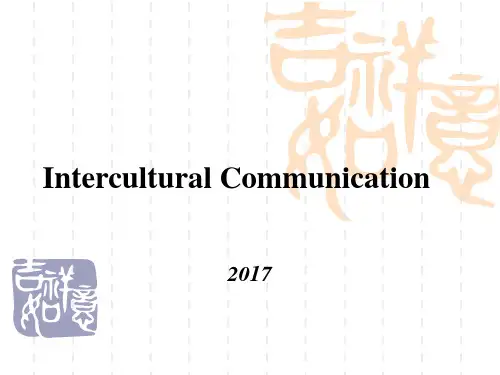
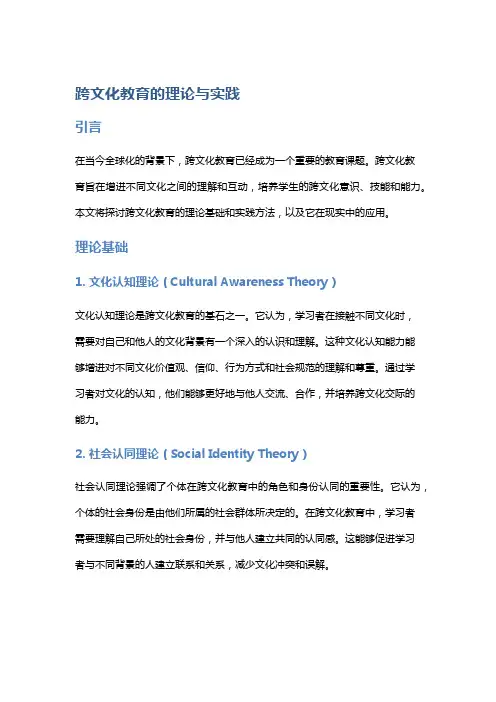
跨文化教育的理论与实践引言在当今全球化的背景下,跨文化教育已经成为一个重要的教育课题。
跨文化教育旨在增进不同文化之间的理解和互动,培养学生的跨文化意识、技能和能力。
本文将探讨跨文化教育的理论基础和实践方法,以及它在现实中的应用。
理论基础1. 文化认知理论(Cultural Awareness Theory)文化认知理论是跨文化教育的基石之一。
它认为,学习者在接触不同文化时,需要对自己和他人的文化背景有一个深入的认识和理解。
这种文化认知能力能够增进对不同文化价值观、信仰、行为方式和社会规范的理解和尊重。
通过学习者对文化的认知,他们能够更好地与他人交流、合作,并培养跨文化交际的能力。
2. 社会认同理论(Social Identity Theory)社会认同理论强调了个体在跨文化教育中的角色和身份认同的重要性。
它认为,个体的社会身份是由他们所属的社会群体所决定的。
在跨文化教育中,学习者需要理解自己所处的社会身份,并与他人建立共同的认同感。
这能够促进学习者与不同背景的人建立联系和关系,减少文化冲突和误解。
实践方法1. 文化交流和互动文化交流和互动是跨文化教育中最重要的实践方法之一。
通过参与文化交流活动,学习者可以亲身体验不同文化,并与他人进行互动和交流。
这可以通过组织跨文化交流项目、国际学生交换和志愿者活动来实现。
通过与他人的交流,学习者能够更好地理解他人的文化差异,并培养尊重和欣赏不同文化的能力。
2. 多元文化课程多元文化课程是跨文化教育中的另一种实践方法。
通过在教育课程中融入不同文化的内容和视角,学习者可以更全面地了解世界各地的不同文化。
在多元文化课程中,学习者可以学习不同文化的历史、传统、价值观和文学作品等。
这有助于他们开阔视野,增进对不同文化的理解和尊重。
3. 跨文化沟通技能培养跨文化沟通技能是跨文化教育中的重要组成部分。
学习者需要掌握跨文化交际的技巧,包括语言沟通、非语言沟通、文化礼仪和适应能力等。

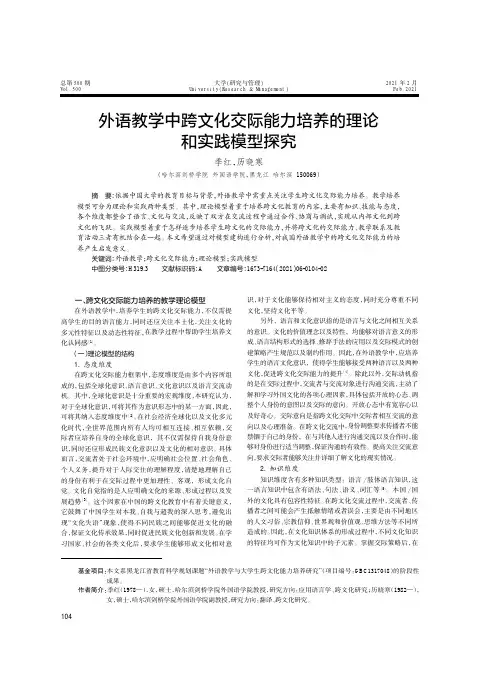
一、跨文化交际能力培养的教学理论模型在外语教学中,培养学生的跨文化交际能力,不仅需提高学生的目的语言能力,同时还应关注本土化,关注文化的多元性特征以及动态性特征,在教学过程中帮助学生培养文化认同感[1]。
(一)理论模型的结构1.态度维度在跨文化交际能力框架中,态度维度是由多个内容所组成的,包括全球化意识、语言意识、文化意识以及语言交流动机。
其中,全球化意识是十分重要的宏观维度,本研究认为,对于全球化意识,可将其作为意识形态中的某一方面,因此,可将其纳入态度维度中[2]。
在社会经济全球化以及文化多元化时代,全世界范围内所有人均可相互连接、相互依赖,交际者应培养自身的全球化意识,其不仅需保持自我身份意识,同时还应形成民族文化意识以及文化的相对意识。
具体而言,交流者处于社会环境中,应明确社会位置、社会角色、个人义务,提升对于人际交往的理解程度,清楚地理解自己的身份有利于在交际过程中更加理性、客观,形成文化自觉。
文化自觉指的是人应明确文化的来源、形成过程以及发展趋势[3]。
这个因素在中国的跨文化教育中有着关键意义,它鼓舞了中国学生对本我、自我与超我的深入思考,避免出现“文化失语”现象,使得不同民族之间能够促进文化的融合,保证文化传承效果,同时促进民族文化创新和发展。
在学习国家、社会的各类文化后,要求学生能够形成文化相对意识,对于文化能够保持相对主义的态度,同时充分尊重不同文化,坚持文化平等。
另外,语言和文化意识指的是语言与文化之间相互关系的意识。
文化的价值理念以及特性,均能够对语言意义的形成、语言结构形式的选择、修辞手法的应用以及交际模式的创建策略产生规范以及制约作用。
因此,在外语教学中,应培养学生的语言文化意识,使得学生能够接受两种语言以及两种文化,促进跨文化交际能力的提升[4]。
除此以外,交际动机指的是在交际过程中,交流者与交流对象进行沟通交流,主动了解和学习外国文化的各项心理因素,具体包括开放的心态、调整个人身份的意图以及交际的意向。
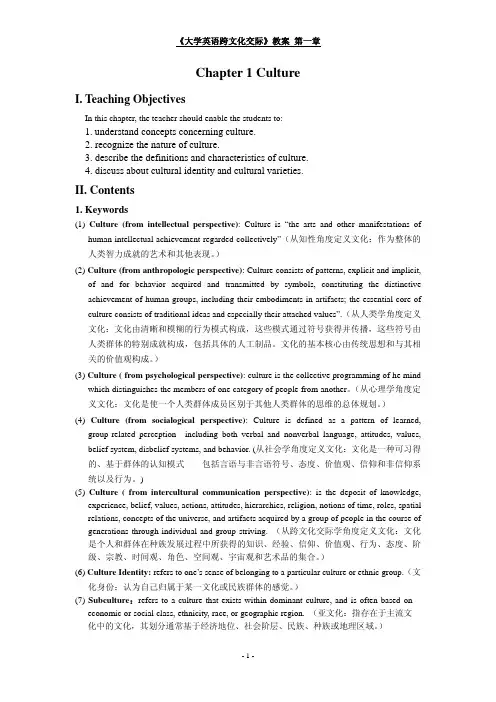
Chapter 1 CultureI. Teaching ObjectivesIn this chapter, the teacher should enable the students to:1. understand concepts concerning culture.2. recognize the nature of culture.3. describe the definitions and characteristics of culture.4. discuss about cultural identity and cultural varieties.II. Contents1. Keywords(1) Culture (from intellectual perspective): Culture is “the arts and other manifestations ofhuman intellectual achievement regarded collectively”(从知性角度定义文化:作为整体的人类智力成就的艺术和其他表现。
)(2) Culture (from anthropologic perspective): Culture consists of patterns, explicit and implicit,of and for behavior acquired and transmitted by symbols, constituting the distinctive achievement of human groups, including their embodiments in artifacts; the essential core of culture consists of traditional ideas and especially their attached values”.(从人类学角度定义文化:文化由清晰和模糊的行为模式构成,这些模式通过符号获得并传播,这些符号由人类群体的特别成就构成,包括具体的人工制品。
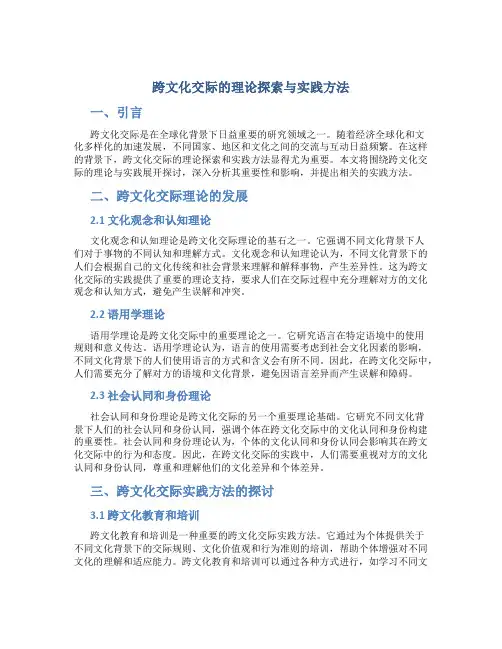
跨文化交际的理论探索与实践方法一、引言跨文化交际是在全球化背景下日益重要的研究领域之一。
随着经济全球化和文化多样化的加速发展,不同国家、地区和文化之间的交流与互动日益频繁。
在这样的背景下,跨文化交际的理论探索和实践方法显得尤为重要。
本文将围绕跨文化交际的理论与实践展开探讨,深入分析其重要性和影响,并提出相关的实践方法。
二、跨文化交际理论的发展2.1 文化观念和认知理论文化观念和认知理论是跨文化交际理论的基石之一。
它强调不同文化背景下人们对于事物的不同认知和理解方式。
文化观念和认知理论认为,不同文化背景下的人们会根据自己的文化传统和社会背景来理解和解释事物,产生差异性。
这为跨文化交际的实践提供了重要的理论支持,要求人们在交际过程中充分理解对方的文化观念和认知方式,避免产生误解和冲突。
2.2 语用学理论语用学理论是跨文化交际中的重要理论之一。
它研究语言在特定语境中的使用规则和意义传达。
语用学理论认为,语言的使用需要考虑到社会文化因素的影响,不同文化背景下的人们使用语言的方式和含义会有所不同。
因此,在跨文化交际中,人们需要充分了解对方的语境和文化背景,避免因语言差异而产生误解和障碍。
2.3 社会认同和身份理论社会认同和身份理论是跨文化交际的另一个重要理论基础。
它研究不同文化背景下人们的社会认同和身份认同,强调个体在跨文化交际中的文化认同和身份构建的重要性。
社会认同和身份理论认为,个体的文化认同和身份认同会影响其在跨文化交际中的行为和态度。
因此,在跨文化交际的实践中,人们需要重视对方的文化认同和身份认同,尊重和理解他们的文化差异和个体差异。
三、跨文化交际实践方法的探讨3.1 跨文化教育和培训跨文化教育和培训是一种重要的跨文化交际实践方法。
它通过为个体提供关于不同文化背景下的交际规则、文化价值观和行为准则的培训,帮助个体增强对不同文化的理解和适应能力。
跨文化教育和培训可以通过各种方式进行,如学习不同文化的语言、参与跨文化交际活动等。
跨文化交际的理论与实践第一章绪论跨文化交际是指在不同文化背景下,通过各种交际方式构建互动关系的一种交际形式。
由于全球化的冲击,越来越多的人涉足跨文化交际,跨文化交际已不再是某些人的特权,而成为了人人必须掌握的能力。
本文将从理论和实践两个角度,阐述跨文化交际的重要性和方法。
第二章跨文化交际的理论2.1 文化维度理论文化维度理论是跨文化交际中最基本的理论之一。
该理论认为,不同国家的文化背景中存在着一系列的文化维度,这些维度包括个人主义与集体主义、权利距离、不确定性规避、男性至上等。
通过研究不同文化背景下的这些维度,可帮助人们理解彼此的差异,从而更好地进行跨文化交际。
2.2 社会语境理论社会语境理论认为,语言不是独立的存在,而是与社会环境相互关联的。
在不同的社会语境中,语言使用者要根据实际情况和交际对象的身份、地位、背景等因素,适时地使用恰当的语言形式。
在跨文化交际中,了解不同文化的社会语境是十分必要的。
2.3 文化认知理论文化认知理论认为,不同文化背景下的人们对同一事物的理解和认知是不同的。
了解和尊重不同文化的认知方式,可以更好地促进跨文化交流。
例如,东亚文化中,沉默寡言被视为一种修养,而在西方文化中,沉默则可能被误解为无礼或者不感兴趣。
第三章跨文化交际的实践3.1 掌握基本交际技巧在跨文化交际中,合适的交际技巧是很关键的。
比如礼貌用语的运用、尊重对方文化习惯、避免敏感话题等都能让跨文化交际更加成功。
3.2 建立良好的跨文化关系建立良好的跨文化关系需要建立互信。
交流双方需要建立起互相尊重、理解的基础上,才能有效地进行跨文化交流。
同时,了解对方的文化背景,尊重其价值观念,可以成为建立互信关系的基础。
3.3 学习不同文化的礼仪习惯礼仪习惯是文化背景中不可忽略的一部分。
在跨文化交际中,不同的礼仪习惯可能会带来不同的效果,甚至影响双方的交流。
因此,学习不同文化的礼仪习惯,避免因文化差异而误解双方交流的意图,是跨文化交际中不可忽略的一环。
跨文化交际的理论与实践跨文化交际是指不同文化间的交流与互动,涉及到语言、价值观、信仰、社会行为等方面的差异。
了解跨文化交际的理论和实践对于促进不同文化间的理解和合作至关重要。
本文将探讨跨文化交际的理论和实践,并提供一些建议以提高跨文化交际的效果。
跨文化交际的理论可以帮助我们理解不同文化间的差异以及如何应对这些差异。
霍夫斯特德提出的文化维度理论是一种常用的跨文化交际理论。
该理论将不同文化按照个人主义与集体主义、权力距离、不确定性规避、男性气质与女性气质、长期导向与短期导向等维度进行分类,帮助人们了解不同文化的特点和差异。
此外,霍尔的高、低语境理论也是一个重要的跨文化交际理论。
该理论指出,一些文化倾向于使用高语境的语言,这意味着他们通过非言语方式来传达信息,比如通过上下文和暗示来理解意思。
而另一些文化倾向于使用低语境的语言,这意味着他们更直接地表达自己的意思,注重文字本身的含义。
在实践方面,提高跨文化交际的能力需要一些具体的技巧和策略。
首先,我们需要保持开放的心态和尊重的态度。
了解并尊重他人的文化背景,包括他们的价值观、信仰和生活方式,是建立良好跨文化交际的基础。
其次,跨文化交际中的语言使用也是一个重要的方面。
我们需要注意语言差异,并尽量避免使用有可能被误解的词汇或口头禅。
尽量使用简单明了的语言,避免使用太多的俚语或隐喻,以确保对方能够理解我们的意思。
此外,非言语交流也是跨文化交际中不可忽视的一部分。
在交流过程中,我们需要注意姿态、表情和眼神的使用。
不同文化对于这些非言语信号的理解和解读可能存在差异,我们应该尽量去了解并适应对方的习惯和要求。
最后,进行跨文化交际时,理解文化差异的意义也是非常重要的。
文化差异不仅仅是表面上的差异,也包括人们在不同文化中形成的思考方式、行为模式和价值观念。
通过理解这些差异,我们可以更好地与他人进行交流,并且从中学习和成长。
综上所述,跨文化交际的理论与实践对于促进不同文化的理解和合作至关重要。